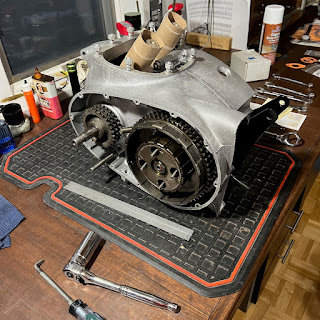So now we're getting down to the final bits and pieces of the build. The speedometer and tach cables were purchased from Vintage British Cables in Canada. They also rebuilt the gages and did a superb job with them. The brake and clutch cables were NOS BSA items which match each other nicely and provide the level of detail I like to perform. Yes I am a rivet counter on my restorations, my riders not so much.
Final details coming together with gage cables in their place and wiring wrapping up.
I had an epiphany on this build. I made a tool to measure the fuel level in the bowls but have only used it with the carbs installed on the bike. It occurred to me that the head is mounted level to the ground so this process could be done on the bench where it is easier and cleaner to do. The process worked well and should produce the same results as when the carbs are mounted on the bike itself.
The carb slide height was set with my tried and true 3/16 drill bit method under the slide cutout....which didn't work on this BSA. I scoured the internet and found a better way to set the slide height is with a .015 inch diameter wire under the non cutout side. I used this technique and the bike started and idled well. Method duly noted.
Setting the float levels with my home made tool worked well.
Performing this task on the bench simplified the process.
New throttle and choke cables were purchased and the original brass junction boxes were cleaned up and reused. A few of the original shorter choke cables also had to be reused as new ones were not available and they were in decent shape. I elected to use the original style single pull throttle for originality.
Control cables mounted and adjusted. I normally use the 3/16 drill bit method to get the slides synched but switched to a .015 diameter wire when it didn't work. See the notes above for details.
The original pipes were in rough shape and were replaced with a set of UK made reproductions from Klemp's in Minnesota. While they were very well made tweaking to get them to fit correctly was required. I have found this common with reproduction pipes. Since there is no connector on these headers I am using high temp Permatex copper silicone to seal the head pipes and hold them in place.
Tweaking the tabs on the pipes to get the proper fit. I find this common on reproduction pipes and prefer to use the originals when they can be restored.
The center stand was bent but I was able to repair it with a little heat and a vice. I compared it to another BSA stand and thought I had it good but alas it was not to be. When the exhaust was installed there was about a quarter inch of interference with the muffler. Paint was stripped and it was heated and bent to clear the muffler while installed on the bike. Not a bad method with hindsight being 20/20. Surprisingly the side stand came out well the first time even though it had a broken mount.
The center stand lever was heated and bent to clear the muffler while on the bike.
This process worked well. Repainted and ready to go.
Final assembly of the air filters, tank and side panels.
Everything covered up to protect from an errant bit putting a ding in my shiny parts
The fuel lines coming together.
Not a bad job if you take your time and use the proper tools.
Petrol lines crimped and ready for assembly.
The tap plungers are being removed to install new corks.
The cables all fit as planned with the exception of the throttle cable which was eight inches to long. I found a process for reworking these bits that provides good results. I unsolder the cable end which is made of steel and reuse it on the shortened cable. I silver solder the cable where it will be cut to stop it from fraying. Using a Dremel with an abrasive wheel to make all cuts keeps the ends clean. Silver solder bonds everything together.
Cable end removed to be reused.
Silver soldering the cable before cutting keeps it from fraying allows the original end to be easily soldered back on.
The kick lever rubber required a little persuasion to mount.
A bit of tire paste and a wood clamp to hold it until it set did the job.
So paint nicks happen....mixing Testors enamel to match BSA "Flamboyant Red"
The build is finally finished. Time to add all fluids, prime the oilways and start it up.
Startup Video: https://www.youtube.com/shorts/GE5AYmh0zIg

The Lightning Rocket performed well in the 2024 Gilmore Car Museum Antique Motorcycle Show by winning 1st place in the Master Class. Scoring 99.75 and starting on the 1st kick made it a good day. Time to hunt down an original throttle housing to earn that last 1/4 point.......
Competing in the "Master Class" at the Metro Triumph Riders Battle of the Britts show in Milford MI the Lightning Rocket was awarded Third Place. Not a bad way to end the show season.....
























































